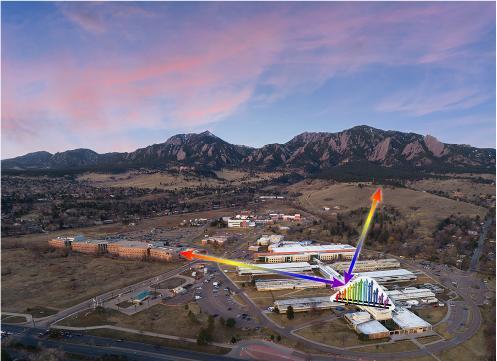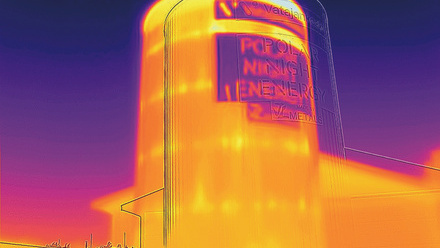NIST laser 'comb' systems now measure all primary greenhouse gases in the air
Researchers at the National Institute of Standards and Technology (NIST) have upgraded their laser frequency-comb instrument to simultaneously measure three airborne greenhouse gases – nitrous oxide, carbon dioxide and water vapor – plus the major air pollutants ozone and carbon monoxide.

National Institute of Standards and Technology (NIST) researchers used a laser frequency-comb instrument to simultaneously measure three airborne greenhouse gases – nitrous oxide, carbon dioxide and water vapor – plus the major air pollutants ozone and carbon monoxide over two round-trip paths (arrows) from a NIST building in Boulder in Colorado, USA.
© N Hanacek/NISTCombined with an earlier version of the system that measures methane, NIST's dual comb technology can now sense all four primary greenhouse gases, which could help in understanding and monitoring emissions of these heat-trapping gases implicated in climate change. The newest comb system can also help assess urban air quality.
These NIST instruments identify gas signatures by precisely measuring the amounts of light absorbed at each colour in the broad laser spectrum as specially prepared beams trace a path through the air.
Current applications include detecting leaks from oil and gas installations as well as measuring emissions from livestock. The team states that the comb systems can measure a larger number of gases than conventional sensors that sample air at specific locations can. They also say the combs offer greater precision and longer range than similar techniques using other sources of light.
The team found that the ratio of excess carbon monoxide versus carbon dioxide agreed with similar urban studies but was only about one-third the levels predicted by the US National Emissions Inventory (NEI). These levels provide a measure of how efficiently fuel combusts in emissions sources such as cars.
The NIST measurements, in echoing other studies suggesting there is less carbon monoxide in the air than the NEI predicts, put the first hard numbers on the reference levels or 'inventories' of pollutants in the Boulder-Denver area.
‘The comparison with the NEI shows how hard it is to create inventories, especially that cover large areas, and that it is critical to have data to feed back to the inventories,’ says lead author, Kevin Cossel.
‘This isn't something that will directly impact most people on a day-to-day basis – the inventory is just trying to replicate what is actually happening. However, for understanding and predicting air quality and pollution impacts, modelers do rely on the inventories, so it is critical that the inventories be correct.’







